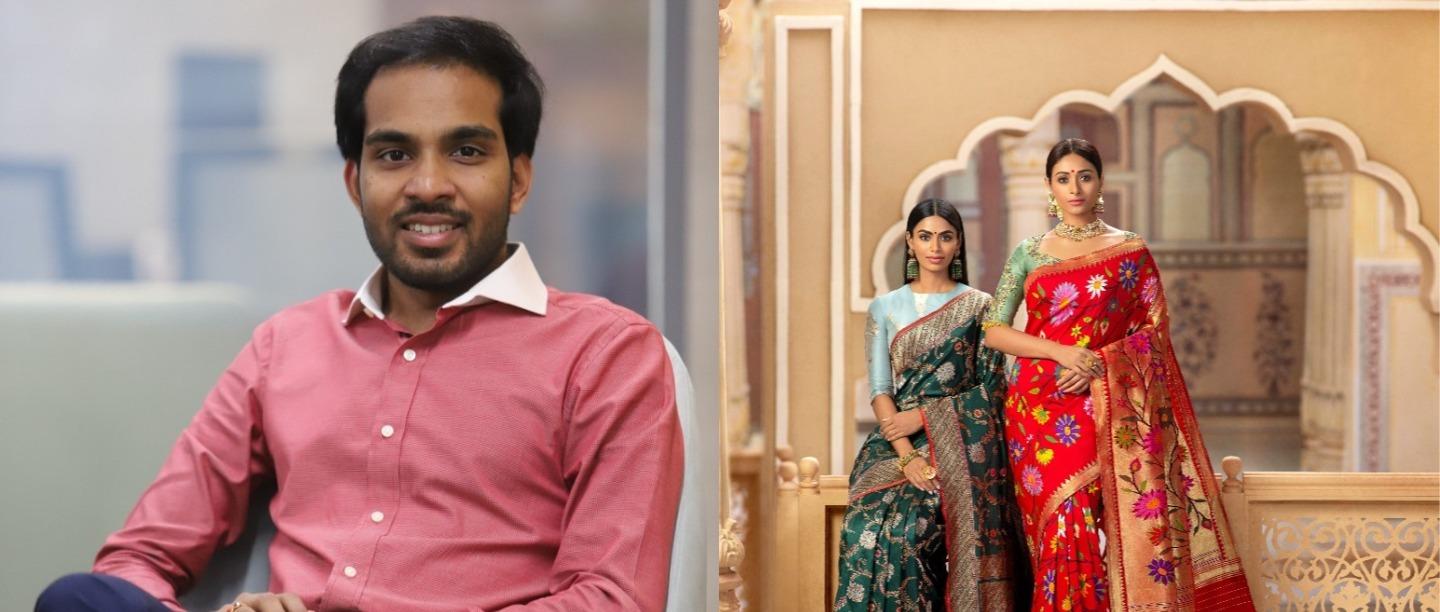Kanchipuram or kanjeevaram reigns supreme as the most favoured silk weave in South India. It is a bridal staple in the region and a trousseau essential for all the brides across the country. However, before we dive into its unique beauty and rich history, let me ask you an interesting question–what is the difference between “Kanchipuram” and “Kanjeevaram.” In case you are tempted to dismiss this query by saying that there is none, let me assure you that it’s not a trick question.
While “Kanjeevaram” essentially refers to a saree weave, “Kanchipuram” refers both to the saree and a quaint town in Tamil Nadu, the birthplace of this handloom wonder. It was Anirudh Kankatala who helped us with this nugget in a recent interaction with POPxo. He is the current director of Kankatala, the iconic saree brand from Andhra Pradesh. As a third-generation entrepreneur in the family business, he is, of course, thorough, with each seam and thread that goes into the making of the grandeur that is Kanchipuram silk. He also talked about the evolution of the weave and its cultural significance. Excerpts below:
The Unique Beauty Of Kanchipuram Silks

Exclusively known for rich gold borders, traditional designs, and dense fabric (which is relatively heavier than the other silk weaves), Kanchipuram sarees are purely hand woven with mulberry silk and pure zari. The sarees have deep cultural relevance for brides in South India especially in the state of Andhra Pradesh, Tamil Nadu, and Kerala. As you might know, Kanchipuram is known as the “city of the thousand temples” in India and its eponymous saree carries heavy influences of the temple architecture from Tamil Nadu.
The unique brocade on the Kanchipuram sarees carries sacred motifs like peacocks, mythological figures, swans, etc. The sarees thus assume a spiritual significance for the wearer and are considered apt for auspicious occasions. “Kankatala has been carrying forward this rich tradition since its inception in 1943. To date, we have been working with the same weaver clusters that we started with 78 years ago and have been thus retaining the essence and opulence of the weave,” shares Anirudh.
Innovation Through Fusion

While Kankatala has ensured to retain the essence of the traditional Kanchipuram, they have also managed to re-invent the craft for a more contemporary palette. They are constantly working on bettering the weave by integrating newer hues, contrasts, and threads. Interestingly, they are mixing handicrafts from different states in India. The very exquisite Bandhani Kanchipuram is a great example. “We make a Kanchiptam saree and then enhance it with Rajasthan’s Bandhani. Both are very old techniques but earlier they were never mixed because of feasibility issues. Rajasthan was all the way in the North and Kanchipurams were being made in Tamil Nadu. We can now bring the best from both the states and fuse them together to create something unique.”
Similarly, at Kankatala they are also fusing Kanchipuram with Kalamkari and digital prints. “These sarees have a different appeal and are apt for the modern brides, more and more of whom are choosing these sarees for their pre-wedding functions,” shares Anirudh.
Beauty In Diversity

As handloom connoisseurs, the Kankatala family has been constantly ensuring that they don’t leave it on any of the glorious handicrafts that India has to offer. Thus, besides Kanchipuram weaver clusters, they have also been working with the Banarasi, Punduru, Khadi Jamdani, Uppada, Venkatagiri, Srikalahasti Kalamkari, Paithani, Kota Silk, Muslin Jamdani, and Badarpur Tussar weavers to name a few.
“We try to work with the majority of weave clusters that we come across. That said, there are many more which are yet to be discovered. Some of these weaves don’t have a commercial value yet but if we find them, we try to make it a point to bring them to the store and explain their significance to the customers. Assam for instance has so many weaves which are not popular commercially like Eri silk. We deal in Eri silk and have been selling it in our stores,” shares Anirudh.”
The Challenges That Lie Ahead

The coronavirus pandemic has cast a dark shadow on the future of India’s handloom industry. In the past year, the sales have plummeted significantly. While things might be heading towards normalcy for the sellers, Anirudh believes that there are bigger challenges that lie ahead. “On the weavers’ side, there have been a lot of difficulties. The next generations of weavers are not ready. If we factor everything in, the demand is already there but the supply is something that is definitely going down and we are going to see an increase in prices in the next couple of years.”
This is a major challenge. Of course, the younger generations from the weaver families are looking at more lucrative career options now. This is where brands like Kankatala are stepping in so as to ensure regular business to their artisans. If that does not happen, eventually handloom would be dead. “We try everything possible to support our weavers. We even pay in advance because otherwise, they will keep making just the basic stuff that is easy to sell. We give them the surety that everything that they are weaving would be purchased by us. Everyone needs to show this kind of support to the artisans right now,” concludes Anirudh.
To celebrate the ethereal beauty and the undeniable allure of Indian handicrafts, we are observing a handloom week this August through a series, titled Seven Days of Handloom. The series aims to introduce designers and brands who are working to preserve and reinvent the Indian handlooms. Click here to read about Handloom Rugs, Chanderi, and Maharashtrian Handloom.



